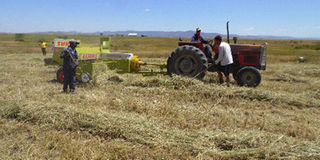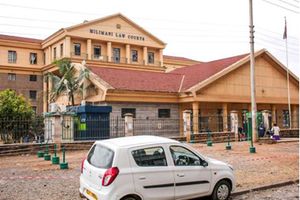Premium
You can’t get Boma Rhodes seeds? Make yours

Ann Munene at her hay farm in Laikipia. PHOTO |CAROLINE WAMBUI|DAILY NATION
What you need to know:
- Boma rhodes harvesting is a process that requires one to be meticulous to end up with the quality seeds at three to six months when they mature
- Harvesting is done using a sickle cell by breaking the flower-head and then spreading it in the sun for a day or two to dry.
- Preserving involves drying the seeds, winnowing and packing in sacks in a well-ventilated, moisture-free store free of pests or rodents.
Lukuai Farm, located 14km from Nanyuki town along the Nanyuki-Doldol Road in Laikipia County, is a vast enterprise, a massive 462 acres.The farm is famed for its beef and various dairy products, some that it exports.
I meet Ann Munene, the farm manager upon my arrival. She is busy on the Boma Rhodes farm, which occupies 20 acres, checking the heads of the fodder.
She presses the grass heads slightly on her palm to check if the seeds will detach, an indication of maturity.
“We harvest our own Boma Rhodes seeds for planting,” says Ann as she checks more grass heads.
How to harvest seeds from Boma grass
It is a process that requires one to be meticulous to end up with the quality seeds at three to six months when they mature.
Harvesting is done using a sickle cell by breaking the flower-head and then spreading it in the sun for a day or two to dry.
The heads are then slightly beaten to extract the seeds. “Heavy beating will only destroy the seeds and produce greater non-seed material that isn’t useful,” cautions Ann.
The seeds are then preserved for planting on the rest of the farm. Preserving involves drying the seeds, winnowing and packing in sacks in a well-ventilated, moisture-free store free of pests or rodents. Wambui highly recommends home-made seeds.
“They are of good quality, are highly adapted to the region and above all cuts cost for the farmer.”
How to grow Boma Rhodes
To plant the seeds, Ann explains that they observe a strict regime because of the desert-like climate of the region that receives erratic rainfall of between 400-700ml per year.
“To conserve both the soil structure and moisture, no cultivation is done. We harrow the farm to create a shallow tilth that helps retain any single drop of water that comes by and besides, Rhodes grass needs only a shallow tilth to germinate,” she says.
The application of manure follows almost immediately after which the seeds are broadcasted at a rate of 8-10kg per acre.
“We use organic manure for two reasons, first it is because it has a long-term effect on the soil and two for quality seeds because the Boma Rhodes grass is a heavy feeder.”
Normally, the seeds are planted a day or two after harvesting because they have a high dormancy rate.
“Early planting is also vital to take advantage of any rain that comes by to trigger germination. This being an arid region, seeds take time to grow due to lack of rain and because Rhodes seeds take longer to germinate, they have to be planted early for nature to break them up.”
Esther Wambui, a private animal health and production practitioner in Laikipia County, warns that as it germinates, the grass should not be grazed on as this will interfere with delicate shoots.
Once the grass has sprouted, it is allowed to establish and only considered for harvest after the six months to give it time to colonise other indigenous grasses.
ADD VALUE
This extended period enables some seeds to be broadcasted by wind and to give the grass time to produce a lot of runners to dominate other grasses.
To add value and improve on quality, the farm intercrops Boma Rhodes grass with lucerne, which is high in protein.
A handful of lucerne seeds are mixed with a basin full of sand then broadcast on one acre.
“Lucerne being a leguminous grass thrives well offering Rhodes nitrogen when the nodule, the roots and the shoots decay.”
Wambui further advises that once lucerne has been mixed with sandoil and broadcasted, it should not be covered with any soil as the shoots are not strong to sprout if covered.
“Once mature, lucerne is harvested at the same time with the Rhodes grass. Harvesting is only done when the conditions for curing are ripe, not when it is raining.”
On the farm, the grass is normally cut and bundled by the hay cutting machine and preserved for sale. The best time to buy hay is when it’s being harvested, as it is cheap, offers Ann.
Loading and offloading of the bales of hay is mechanised.
“The more the hay is handled by human beings, the more the physical condition deteriorates and contaminated making it unsafe for livestock consumption,” she explains.
Hay from the farm is supplied to dairy farmers in Laikipia, Meru, Isiolo and Nyeri counties





